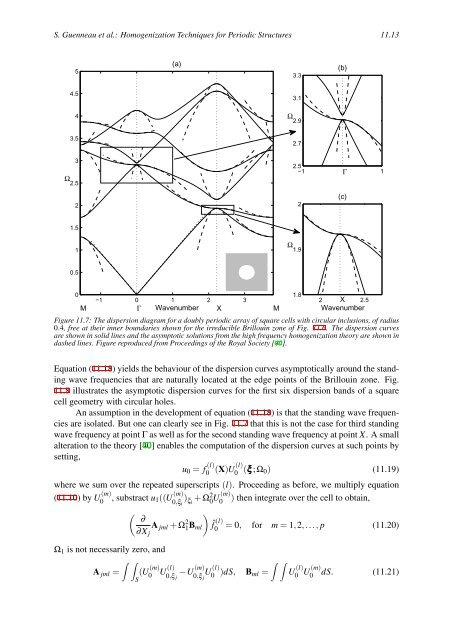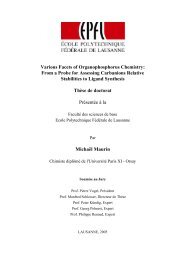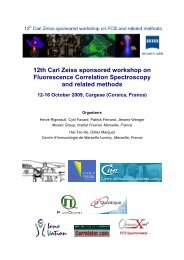GratinGs: theory and numeric applications - Institut Fresnel
GratinGs: theory and numeric applications - Institut Fresnel
GratinGs: theory and numeric applications - Institut Fresnel
You also want an ePaper? Increase the reach of your titles
YUMPU automatically turns print PDFs into web optimized ePapers that Google loves.
S. Guenneau et al.: Homogenization Techniques for Periodic Structures 11.13<br />
5<br />
4.5<br />
4<br />
3.5<br />
3<br />
Ω<br />
2.5<br />
2<br />
1.5<br />
1<br />
0.5<br />
0<br />
M<br />
(a)<br />
−1 0 1 2 3<br />
Γ Wavenumber X M<br />
3.3<br />
3.1<br />
Ω<br />
2.9<br />
2.7<br />
(b)<br />
2.5<br />
−1 Γ<br />
1<br />
2<br />
Ω<br />
1.9<br />
1.8<br />
(c)<br />
2 X 2.5<br />
Wavenumber<br />
Figure 11.7: The dispersion diagram for a doubly periodic array of square cells with circular inclusions, of radius<br />
0.4, free at their inner boundaries shown for the irreducible Brillouin zone of Fig. 11.6. The dispersion curves<br />
are shown in solid lines <strong>and</strong> the asymptotic solutions from the high frequency homogenization <strong>theory</strong> are shown in<br />
dashed lines. Figure reproduced from Proceedings of the Royal Society [40].<br />
Equation (11.18) yields the behaviour of the dispersion curves asymptotically around the st<strong>and</strong>ing<br />
wave frequencies that are naturally located at the edge points of the Brillouin zone. Fig.<br />
11.8 illustrates the asymptotic dispersion curves for the first six dispersion b<strong>and</strong>s of a square<br />
cell geometry with circular holes.<br />
An assumption in the development of equation (11.18) is that the st<strong>and</strong>ing wave frequencies<br />
are isolated. But one can clearly see in Fig. 11.7 that this is not the case for third st<strong>and</strong>ing<br />
wave frequency at point Γ as well as for the second st<strong>and</strong>ing wave frequency at point X. A small<br />
alteration to the <strong>theory</strong> [40] enables the computation of the dispersion curves at such points by<br />
setting,<br />
u0 = f (l)<br />
0 (X)U(l)<br />
0 (ξξξ ;Ω0) (11.19)<br />
where we sum over the repeated superscripts (l). Proceeding as before, we multiply equation<br />
(11.10) by U (m)<br />
0 , substract u1((U (m)<br />
0,ξi ) ξi + Ω2 0 U(m)<br />
0 ) then integrate over the cell to obtain,<br />
Ω1 is not necessarily zero, <strong>and</strong><br />
∫ ∫<br />
A jml =<br />
(<br />
∂<br />
A jml + Ω<br />
∂Xj<br />
2 )<br />
1Bml<br />
S<br />
ˆf (l)<br />
0<br />
(U (m)<br />
0 U(l)<br />
0,ξ j −U(m)<br />
0,ξ j U(l)<br />
0 )dS, Bml =<br />
= 0, for m = 1,2,..., p (11.20)<br />
∫ ∫<br />
U (l)<br />
0 U(m)<br />
0<br />
dS. (11.21)













